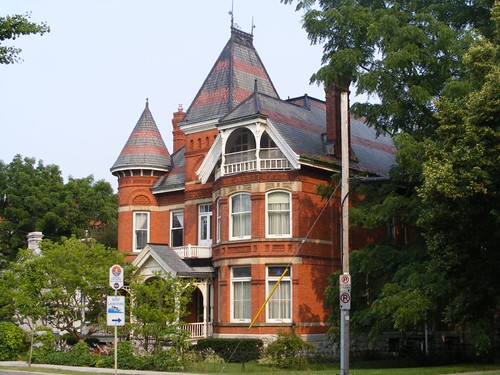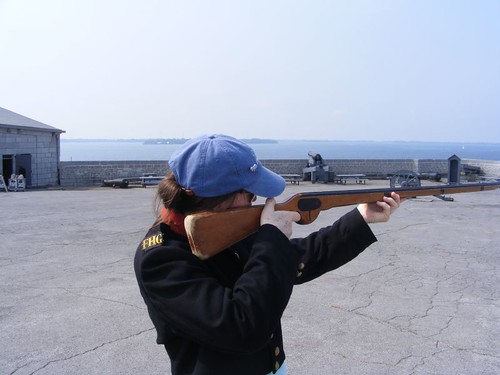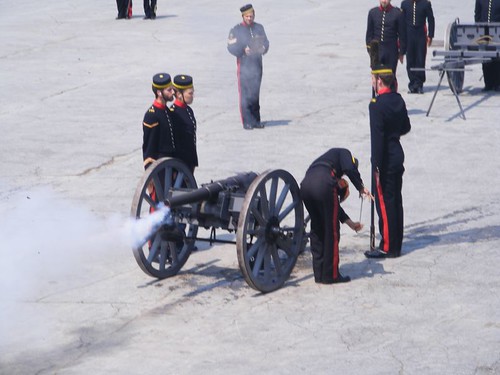July 19 – 20, 2010
It sure was a contrast pulling into the congested area of Kingston compared to what we had experienced in the Thousand Islands areas of the St. Lawrence River. We passed through a huge breakwater that separates the inner harbor of Confederation Basin Marina from Lake Ontario and the mouth of the Cataraqui River. We could see a sign that said “Day Docks”, but we could not fit on any of them, and at that point it wasn't clear if we could tie up to the big wall that was adjacent to those docks. So, we called on the radio and asked if we could get a slip in the marina for the night. At the same time, at least 3 other boats were calling and asking for the same thing. The cruising guide says to make sure you make a reservation ahead of time.
We lucked out and were assigned a slip much to our liking: the last one on the end of the farthest out main dock. The ad for the marina says that there are 300 transient slips available. By the time we were docked, the radio chatter already indicated that they were turning boaters away because space was no longer available. The place is gigantic, so it was about ¼ mile walk from our slip to land.
We were learning 3 new Canadian words. Hydro means that your boat needs to have an electric hook-up, and most all of the Canadian boaters are addicted to Hydro. Their go-fast boats have very small battery capacities that get depleted daily when they are at a dock living like they are really still at their house, so they have to be recharged with electricity. That always costs extra at any dock. Our battery bank is huge, and our solar panels get us fully charged on most days. Looking at all the power cables when going from our slip to shore you would think the marina needs its own power-generating station.
Our next two new words dealt with the currency. We never really looked closely at the money, but realized that the smallest paper denominations start at $5 bills. There are $1 gold-colored coins called Loonies because they have a loon on them. We were at the Farmers Market, and a vendor asked me to give her a Loonie, and I had no idea what she was talking about. There are gold/silver-colored $2 coins that they call Toonies, which is weird because they have a bear on them. I guess they didn't want to call them Bearies, because that would really sound fruity. I think it is a good idea using the $1 and $2 coins because they must last a lot longer than paper money, and must save the country's Mint some printing costs.
The Tourist Information Office is located right next to Confederation Basin, and it is the best place to get all the information you need for what you want to do. The TIO is located right in the old Kingston and Pembroke Railway Station building, the original jumping off place for historic downtown Kingston. We picked up a series of free walking guides, ranging in length from 20 – 45 minutes each which guide you on a street walk with color photos and information about buildings of historical significance. They are a great way to see the city and know what you are looking at. If you don't want to walk, there is a 50 minute Trolley Tour that leaves on the hour. Remember all that pastry we've been eating? We needed to walk!!
The impressive City Hall building is located right across the street from the TIO. When it was originally built in 1844 it held all kinds of public office functions. The building is what is architecturally called Paladian, meaning the two sides are mirror images of each other. I really liked the clock tower because you could see the time from many places in the city. This impressive building was originally started to be built when Kingston was going to be the capital of Canada. However when the capital got moved during construction, the city of Kingston couldn't afford to pay for it. So, it had to be subdivided and rented out for any business that wanted to pay from churches, saloons, and even a medical college.
The rest of the downtown business area is a mix of some old, interesting, historic buildings with interesting features, as well new buildings. There are MANY shops of all kinds, restaurants, and pubs to cater to all the pedestrians and bicyclists.
We also incorporated some business into the downtown part of the tour. We stopped into a phone store with the idea that we would buy a throw-away phone and some minutes to use while we were in Canada. A very pleasant, twenty-something, clerk jumped forward to help us as soon as we walked into the store. We told him what we wanted, and with a bemused look on his face (and his two female co-workers), he said that there was nothing like that available in Canada. The “best” plan he could offer us started at $150. We really had no intention of spending that kind of money for as little as we planned to use a phone, so we asked him what the other choices were. The best way for us to go was just to get one of those phone cards that you buy for a specific amount of minutes and then use a pay phone to call from. I told him it was almost impossible to even find pay phones anymore back in the U.S., so we hadn't thought of getting the cards. As it turned out, the pay phones are easy to find and use. The card minutes only cost about $.03 anyway.
We also learned that alcohol is only sold in “government-licensed” stores, and they are not conveniently located every couple of blocks. We were getting low on beer, and thought it would be easy to get some in town, but the store was farther away than what we wanted to take the time to go to. Carrying it back to the boat would have been a pain too, so we would wait for the next opportunity. I am amused thinking about how spoiled Americans are when it comes to having such easy access to their alcohol and wonder how many of those same people that support so much government intervention in our lives would like the government controlling access to alcohol with even higher taxation and accessibility like we see here.
After our tours of the downtown business streets, we decided to walk around a couple of the residential streets. Most of the featured homes were considered mansions in their days, mid-1800s, and still have an enormous amount of curb appeal today since they are so unique with fascinating architectural detail in stone, brick, wood, and metal works of varying sorts. It would be easy to spend the day photographing all the different home styles and difficult to pick out one favorite.
I liked the homes that had retained the original carriage ways because you could peek through the carriage way and see pretty, quiet backyard gardens.
This 1886 two-story Victorian, of the Queen Anne style, was originally built for a prominent, whole-sale grocer.
Only Wayne and I had walked through the residential areas, so when we got back to FLUKE, Eddie was out on the dock talking to a guy and his son a couple of boats away about our spearfishing adventures. To really authenticate the conversation, he came back and got MY spear and was showing them how it worked. Unfortunately, he hadn't hooked up the rubber band handle correctly, and when he shot it into the water the band came off the handle, letting the spear sink 20' down out of sight. While loosing my spear wasn't as bad as loosing Ursa, I was not a happy crew-mate to say the least.
The following morning we moved FLUKE over to the day dock wall, which we had learned was for the big vessels to tie up to, but it didn't have any Hydro so wasn't a first choice for most of the other boaters.
Then we were going to walk over to Fort Henry, a couple of miles away. That required having to walk by the Royal Military College, Canada's Westpoint. There are a couple of displays on the outer perimeter of the property. Eddie was fascinated by them.
If Eddie hadn't lost my spear, maybe he could have used it for defense.
Fort Henry sits on a high, open hill overlooking Lake Ontario and the Royal Military College. It seems like a long hike up to get to the entrance to the fort. All the vacant land around the fort was designed to be part of the defense of the fort against invasion by the enemy forces, the U.S. At least they've gotten over that paranoia now, and no one shot at us.
The reason that defense of the Rideau Canal was important was because it had become the major supply line for shipment of all goods between Ottawa (and other inner lands) and the port of Kingston. The Canadians couldn't safely rely on transporting anything along the St. Lawrence because the river system was too vulnerable from attack by the greedy Americans.
It's a good thing I don't write history books, huh?!
Interpretive guides are available for small group tours. The year is 1867, the year Canada became a nation, and the tour guide relates what life is like on a daily basis during that time period.
The fort was heavily stocked with all kinds of cannon that could shoot a different type of shot varying distances. We learned that some kinds of cannons are used for shooting over water and some are used for shooting at land forces.
Military strategists knew that the most likely route of attack would be from the land (north) because the enemy would have an easier time accessing the fort from the land than the water. The lake and river were easy for the Canadians to reasonably defend from attack.
There are a bunch of different types of uniforms and fake muskets available so that visitors can stage their own fort life photographs. I was glad the gun was fake because I would have been really tempted to shoot Eddie for wasting my spear.
The fort has several of these flanking ditches, 30 feet deep and 40 feet wide. They are designed to thwart enemy attack by making it difficult to access points in the fort. If the attackers were in the ditch, fire from the fort would ricochet off the thick, granite walls, making fatalities more likely.
Parts of the fort are also surrounded by reverse firing chambers that look similar to these flanking ditches. Soldiers could fire out of slits in the fort walls and the bullets would bounce off the chamber walls many times, increasing the chances of finding a target. There were even sections cut into the sides of the chamber that housed cannons that could also fire a number of different types of ammo that would ricochet throughout the chamber. Having to man one of those cannons was an ill-fated job, as there would be many accidents and danger of getting hit from the fort's own ricocheting bullets.
The colorful Martello towers (now orange tops) are still visible in several locations on the Kingston waterfront, not just at the fort. They were used as sentry posts and housed small groups of soldiers that could help defend against attacks from the water. The roof of the building could be quickly dismantled so that a cannon could be shot in a circular fashion around the top of the tower. Slits in the sides of the thick towers allowed for rifle shooting.
There are several types of reenactments that visitors can watch throughout the day. This 7-man cannon firing competition took place in the big internal fort parade ground and is patterned after those that actually did take place. Training was very important to maintain order and discipline, help relieve boredom, and be enemy attack ready. To make it more interesting and efficient, they held competitions between teams and rewarded the winners, with food or ale supplements. Despite all the training and having built the wonderful fort, Fort Henry was never attacked and really put to the true test.
When the Royal Welch Fusiliers served at Fort Henry from 1842-43, they had a goat mascot. In commemoration of their service, the St. David's Society of Toronto supplies white Saanen goats to the fort as today's mascots. This is David 10th. Each David can stay on the job for about 7 years if they behave properly. Number 10 is only 4 months old; I was surprised by his big horns.
After a long day of finishing up our Kingston adventure, we took the 6:00 p.m. bascule bridge opening into the Inner Harbor where we planned to anchor for the night. It took us over an hour to anchor in the thick, too-soft gooey mud on the east side of the causeway. We really weren't satisfied with the holding, but with light winds expected out of the south, the causeway was giving us some protection from the wind, and we were the only boat on that side. About a dozen boats were anchored on the west side, but we prefer to not “hang with the pack” in case some weather change does occur. We doubted any of those boats had better holding ground than we did.
Over a late dinner, we contemplated what adventures our trip north up the historic Rideau Canal might bring. I will say, at this point, ignorance is really bliss!
Monday, August 08, 2011
Subscribe to:
Post Comments (Atom)





















So, how much beer can you get at the Gov'ment store for a loonie toon ;-)
ReplyDeleteJerry